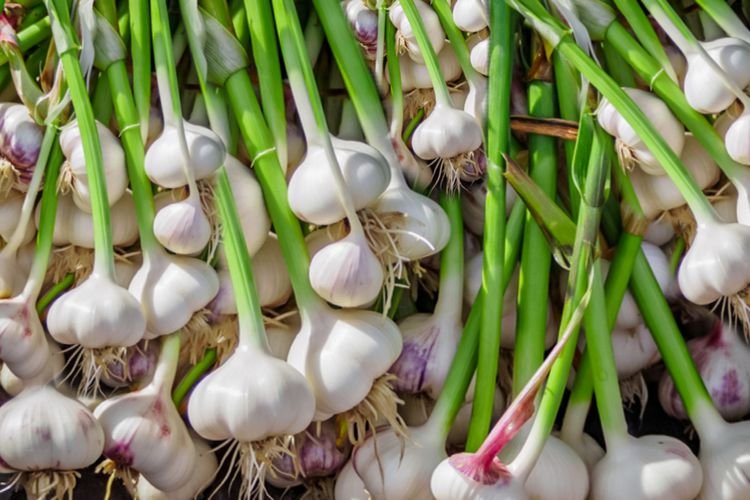The Protective Qualities of Garlic: From Ancient Egyptian Magical Rituals to Modern-day Sustainable Pesticide
Throughout history, garlic has been celebrated not only for its culinary uses but also for its perceived protective qualities. From ancient Egyptian magical rituals to modern-day sustainable pesticide solutions, the multifaceted benefits of garlic have captivated the imagination of people across cultures and generations. Ancient civilizations revered garlic for its protective properties. In ancient Egypt, garlic was thought to bestow strength. It was used in ceremonial rituals as it was believed to offer protection against evil spirits and promote overall well-being. The ancient Egyptians thought garlic and onions aided endurance, and therefore consumed large quantities of them. Raw garlic was given to asthmatics and to those suffering with bronchial-pulmonary complaints. During the building of the Pyramids, the workers were given garlic daily to give them the vitality and strength to carry on and perform well. Cloves of garlic have been found in Egyptian burial sites, including the tomb of Tutankhamen and in the sacred underground temple of the Apis bulls at Saqqara. For millennia, the protective qualities associated with garlic continued to be embraced across various cultures. In ancient Greece and Rome, garlic was believed to provide courage and physical strength to athletes and soldiers. Its use was not only confined to medicinal applications but also extended to the realm of spiritual beliefs and folklore. The protective reputation of garlic persisted through the ages and found its way into European traditions and folklore. In the Middle Ages, garlic was considered a powerful ward against vampires and demons, and was often worn or hung around doorways to provide protection. Its pungent aroma and potent properties made it a symbol of strength and defense.
Moving into more modern times, the protective qualities of garlic have extended beyond folklore and into the realm of science and agriculture. Studies have revealed a range of protective benefits associated with garlic, including its antifungal, antibacterial, and antiviral properties. Garlic's antimicrobial properties have made it a popular natural remedy for various infections, leading to its use as a protective agent against common illnesses. The sulfur compounds in garlic, including allicin, have been the focus of numerous scientific investigations. Allicin is formed when garlic is crushed or chopped and is believed to be responsible for many of garlic's protective effects which is why when preparing garlic, it's best to crush or chop it and let it sit for a few minutes before cooking. This can help activate the formation of allicin, the compound responsible for many of garlic's protective properties.
Garlic's protective qualities have also been linked to cardiovascular health. Research has suggested that garlic may help lower cholesterol levels and blood pressure, and some studies have explored its potential protective role against heart disease. The protective effects of garlic on cardiovascular health are thought to be related to its ability to improve blood circulation, reduce inflammation, and provide antioxidant support. By promoting optimal cardiovascular function, garlic offers protective qualities that contribute to overall heart health and well-being. Additionally, the protective qualities of garlic have been studied in relation to cancer prevention and treatment. Some research has explored the potential anticancer properties of garlic, focusing on its ability to inhibit the growth of cancer cells and promote cancer cell death. While further studies are needed to fully understand the impact of garlic on cancer, these findings highlight the potential protective qualities of this ancient bulb.
Sustainable Organic Garlic Pesticide (Image Source)
The potential protective qualities of garlic have also been explored in the context of agricultural practices. As concerns about synthetic pesticides and their impact on the environment and human health have grown, organic and sustainable alternatives have garnered attention. Garlic has emerged as a natural, sustainable pesticide with protective properties for crops. Garlic-based pesticides have been studied for their potential to control various pests and fungal diseases. These natural solutions offer a protective approach to managing agricultural challenges, while also aligning with sustainable and environmentally conscious practices. By harnessing the protective qualities of garlic, farmers can reduce their reliance on synthetic pesticides and contribute to more sustainable agricultural systems. Moreover, garlic-based solutions have been explored for their potential to support soil health and promote ecological balance in agricultural ecosystems. The protective qualities of garlic extend beyond its direct effects on pests and pathogens, as it may also contribute to broader ecological resilience in agricultural environments.
For thousands of years, the protective reputation of garlic has endured. From ancient Egyptian magical rituals to modern-day sustainable pesticide solutions, garlic continues to fascinate and inspire. For thousands of years, garlic has been used as a remedy by our ancestors not only for our bodies, but for our souls, spirits, and even our lands. Today these ancient beliefs are being supported by scientific evidence as we discover modern applications in agriculture and healthcare to this ancient bulb. As our understanding of its protective qualities grows, garlic's diverse applications in various domains serve as a testament to its enduring significance in human culture and society.



